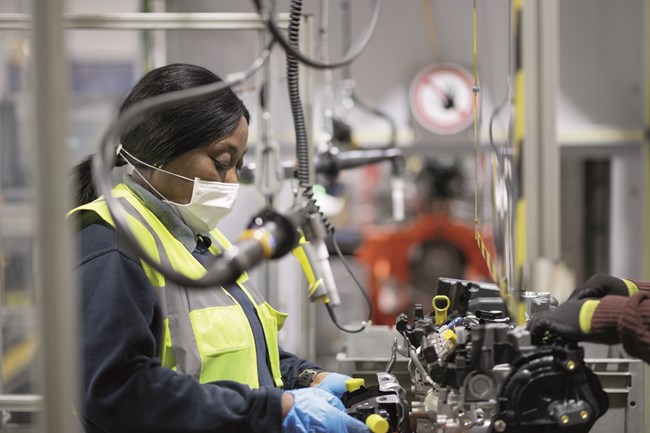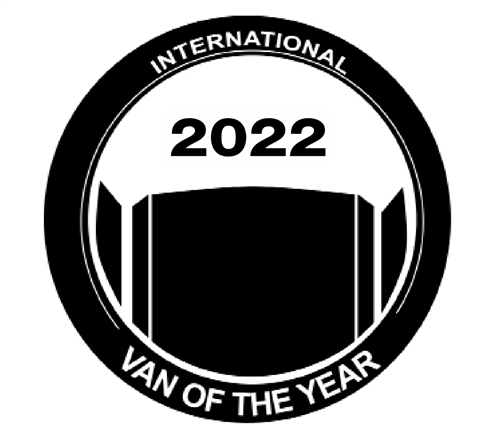- ETRUX launches new Ford E-Transit Trizone
- Renault gives UK debut to Master E-Tech at CV Show
- Isuzu D-Max long-term test – Latest Report
- Isuzu D-Max V-Cross Steel Edition revealed
- IVOTY Report: Stellantis explores the hydrogen proposition
- New Maxus EVs include eDeliver 5 van
- Used LCV values reach six-month high
- ADVERTISEMENT FEATURE: IVECO Daily Mission Awards 2024 Q2 Round-up: Grounds Maintenance & Forestry
- Stellantis Pro One electric vans review
- Mitie adds 5,000th EV to fleet
IVOTY Analysis: Have we reached peak diesel?
Date: Wednesday, August 24, 2022 | Author: George Barrow
As time runs out for the combustion engine, how much will manufacturers invest in new technology before the 2030 deadline?

Diesel engine technology probably peaked in 2020. That’s not a fact, but an observation based on the timelines for the ever increasingly complicated Euro emissions regulations. There have been only incremental upgrades to engine technology since the introduction of Euro 6 and its subsequent Euro 6b, Euro 6c, Euro 6d-TEMP and most recently, and appropriately named,
Euro 6d Final focusing on ever narrower NOx emissions as well as PM10 and PM2.5 particulates.
But since the date for type approval of the last Euro 6d standards was January 2020 (with all new vehicles registered after January 2021 having to comply) it is, as it stands, the last set of emissions regulations diesel engines will have to meet.
That’s because there is currently no sign of Euro 7 being implemented by the European Commission, despite The European Automobile Manufacturers’ Association (ACEA) having submitted its proposals for Euro 7 regulations more than a year ago. Even a shortened time frame for introducing new regulations would likely not see them come into effect before 2026, by which time the industry is perilously close to the European-wide 2030 combustion engine ban deadline. Ultimately, it begs the question, will manufacturers even bother to update their diesel model range to meet Euro 7?
Preserving market share will of course come into the equation of whether or not to invest in new engine technology, and many manufacturers will feel morally obliged to carry on pushing the cleanliness of the technology forward. But with so little time to recoup their investment before the 2030 sales cut off, new diesel engine spending will come under some serious scrutiny.
Global engine strategies may justify the expense, such as Ford’s four-cylinder Panther unit, which is used in a diverse range of products as a 2.0l commercial vehicle engine in Transit and Ranger, as well as a 1.5l engine in passenger cars including the Focus and Puma in Europe, Australia, South Africa and Asia. A diverse range of applications in markets operating on different timelines and emissions targets, in addition to countries that aren’t banning internal combustion engines (ICE), might warrant continuing development. Ford also still expects one third of its sales in Europe to be diesel by 2030, many of which will be commercial vehicles, and has assigned its Dagenham facility an important role. As much as 60% of its output will be used in the Transit Custom and one-tonne Volkswagen vans being built in Kocaeli, Turkey.
Diesel engines will still play an important role in the commercial vehicle sector in the period between 2025 and 2030, but current spending on electric vehicle development would suggest that most manufacturers are investing heavily in alternative drivelines, possibly at the expense of diesel and other ICE development. Ford says it has been averaging an investment of £450m in R&D expenditure per year over the past decade but that its future spend will all be around electric vehicles only. Globally, Ford plans to invest over $50bn (£41bn) in EVs through to 2026 where they hope to have battery capacity for more than 2m vehicles annually with a target of 600,000 units by the end of 2023 alone – 150,000 of which will be electric Transit vans.

“This is our opportunity to win a whole new group of customers, building their loyalty and advocacy as we grow our market share,” said Marin Gjaja, Ford model e chief customer officer.
Ford is not alone in turning its investment attentions towards electric vehicles. Mercedes-Benz Group invested €2.2bn (£1.9bn) in Q2 2022 alone, with around €350m (£295m) having been currently spent on the development of the next generation eSprinter and a further €50m (£42m) spent on adapting production lines at the three plants (North Charleston, Düsseldorf and Ludwigsfelde) that will produce the new model from the second half of 2023. Despite Mercedes-Benz making a habit of not commenting on future product development, in its quarterly statement, the brand said: “Investments in property, plants and equipment and research and development are expected to remain “significantly above” prior-year levels due to spending to upgrade existing combustion engine platforms and to develop the electric VAN.EA platform.”
Aside from Q2 2022 group spending being down on their Q2 2021 spending (€2.4bn)(£2.0bn), it would suggest there is still life in the ICE models – although not necessarily their engine development. The VAN.EA platform and communications relating to the group’s electric strategy, however, suggests that diesel will take a back seat after 2025 when a new modular electric-only architecture will be introduced with all newly developed vans going forward being electric only. Three all-electric platforms will be born with MB.EA (Mercedes-Benz Electric Architecture) for medium- and large-size vehicles, such as current models EQC and EQS – an AMG.EA platform for its prestige and performance cars, which will likely see the end of ICE models of Maybach and G Wagon cars and the aforementioned VAN.EA for new electric Sprinter and Vito models.
This electric-only strategy coincides with the development of a new Mercedes-Benz Operating System (MB.OS) to connect its vehicles to the cloud, enabling autonomous driving, new charging and management systems as well as being the backdrop to its MBUX infotainment systems, from 2024. Mercedes has also previously said it will reduce its investment in ICE and plug-in hybrid models by 80% from 2019 to 2026.
It’s a similar story in Wolfsburg where Volkswagen’s R&D investment has already totalled €9.3bn (£7.8bn) in the first half of this year – up from €7.7bn (£6.5bn) during the same period in 2021 – with group BEV deliveries up by 27% in the same period.
“The group’s strong operating profit and financial position enables important investments in future profit pools,” said Volkswagen CFO Arno Antlitz in its half-year financial statement. “Volkswagen also made important strategic progress in the second quarter and significantly advanced the development of its battery, mobility services and software platforms,” Antlitz added.
Production of the new ID Buzz and ID Buzz Cargo in Hannover will only enhance Volkswagen’s electric ambitions with an anticipated 55% split for battery electric vehicle sales in Europe by 2030. However, with its future commercial vehicle products largely coming from the collaboration with Ford, including the one-tonne van and Amarok pick-up truck, Volkswagen’s own ongoing expenditure in ICE development in commercial vehicle products is likely to be limited.
For Stellantis, the objective is clear having revealed its mission statement for commercial vehicles to be “The Global Leader in e-Commercial Vehicles” and plans to support its electrification strategy across its 14 brands with €30bn (£25bn) of investment through to 2025. The early adoption of fuel cells in commercial vehicles, a strategy which will extend to all commercial vehicle brands, including RAM in the US with its notoriously large and powerful petrol engines, will further jeopardise investment in ICE technology. In the face of governmental, public and investor pressure, manufacturers are becoming increasingly vocal about their green intentions but the trend itself is nothing new. Previously, several manufacturers have made clear indications that their combustion engine spending will stop, most notably back in 2017 when Volvo said its spending would focus on pure electric models, outlining its intentions to be the first manufacturer to do so. Porsche also confirmed diesel would no longer appear in its range from the end of September 2018.
Despite the ongoing need for diesel engines in commercial vehicles currently presenting a strong case for customer TCO, reliability and flexibility over a BEV alternative, the wider green agenda of the manufacturers and their race to secure revenues in the zero-emission passenger car market will invariablely lead to an even more dramatic decline in diesel engine investment. Consultancy firm AlixPartners estimates $526bn (£435bn) will be spent collectively by vehicle makers on electric vehicles before 2026 – expenditure far greater than those currently stated by the major manufactures outlined above. Even if there is high demand for diesel engines in commercial vehicles past 2030 in markets beyond Europe, it would appear that investment in new technologies will outweigh the budgets for ICE models.
Whether industry estimated costs of more than £1bn per engine to make the jump from Euro 5 to Euro 6 were accurate, any sizeable future spending on Euro 7 seems unlikely given the scale of EV spending already ring-fenced by each manufacturer. The reality may be that diesel engine emissions will not improve beyond their current state.
Downtime for diesel investment
During the past few months, I’ve spoken with many engineers and executives alike about the future of the zero-emission commercial vehicle, but one thing that hasn’t come up is the diesel engine.
Don’t get me wrong, new diesel-engined vans are still coming to market but the focus is net zero, and if my conversations with the decision makers at many of the manufacturers echoe the future of the industry it will be a very lean decade for diesel engine investment and innovation.
Unsurprisingly, manufacturers are embracing the benefits EVs can bring. Mark Barrett, Maxus general manager summed it up neatly when he told me: “An electric motor is an electric motor in every country, whereas a diesel engine has to conform to many different standards with varying restrictions across different cities.”
He added that: “Investing in diesel is not a high priority for us. The interest in EVs in particular has soared. We’re finding that the difference between now and a few years ago is individuals and businesses are taking action and green mobility is a firm part of their strategies.”
His feelings are echoed by the rest of the industry, with everyone looking to capitalise on the surging interest in EVs. Ironically, for me, the hardest part of examining what the future of the diesel commercial vehicle engine might be was getting people to not talk about electric.
George Barrow is the UK judge for the International Van of the Year, the prestigious prize awarded by leading European LCV journalists.
View The WhatVan Digital Edition


